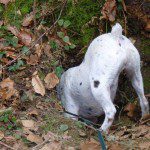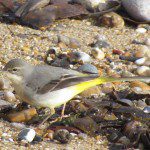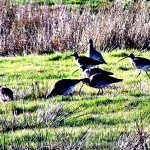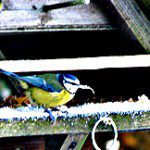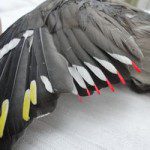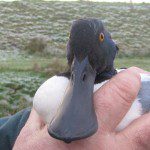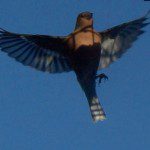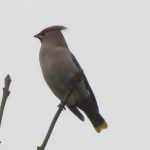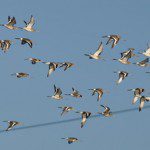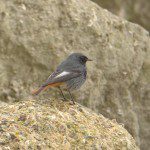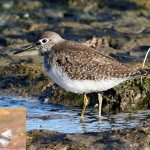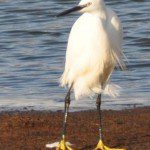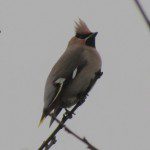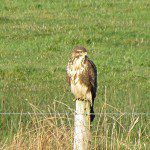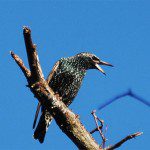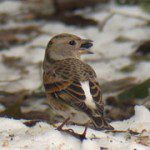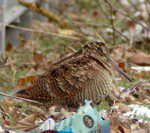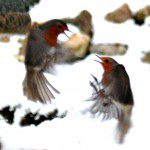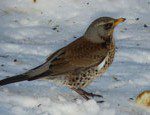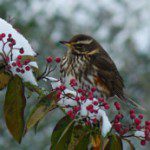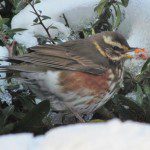NB: The following is reproduced by kind permission of Axe Estuary Birds. Full credit goes to the team that produces the newsletter (see the bottom of the post for specific details). Photographs are credited throughout the text although we are working to preserve the original layout wherever possible in the future.
Axe Estuary Birds No 149 31st January 2011
The Birds
There was a Grey Wagtail at Seaton Hole 21/1, which Sue Smith managed to photograph.
Some good news about the Colyton Waxwing sightings over Christmas (One on wires above Rosemary Lane, Colyton on Christmas Day and five in a garden by the river on Boxing Day: Steve Waite has been in contact with the lady who saw them and has told me that her written description will be acceptable so we have a new species for the ‘patch’ !
Steve managed a look on the sea off Branscombe one morning, with Ian McLean. This showed 20+ Red-throated Divers, good numbers of auks, and a Velvet Scoter passed west. The next day off Seaton, he could see only seven Velvets, the week before he counted 11 – his highest count for the patch ever!
A couple of weeks ago in daylight after a wet night Ian Waite saw a Barn Owl fly across Musbury Road near Axmouth F.C. towards Lower Bruckland Farm chased by two Crows.
On 29th a Jack Snipe flew from Salt Marsh in front of the Hide at Seaton to the Lagoon where it quickly disappeared in vegetation.
There are now approx. 90 Dunlin on the River.
Ian McLean also tells of 30 Common Scoter and Nine Red Throated Diver on the sea, two Pintail on 5th, a Gadwall on the 14th, a Great Skua on 24th and ten Shag off Branscombe on 25th.
From Colyford Common Log Book, Bob Olliver highlights the following:- An estimated 1,000 Wigeon (11th) were spread across the marsh and into neighbouring Bridge Marsh near the A3052 with 200 Teal on the same day.
Two Buzzards on the 10th were of interest, one being very dark and the other strikingly white about the head and breast; the latter was perched on a post close to the river looking for all the world like a distant osprey! A male Marsh Harrier was logged on 16th.
Lapwing numbers were high on 10th and 11th with some 500 on Colyford Marsh and a further 1,000 on Bridge Marsh. A single Golden Plover was again picked out (11th) and there were 40 Snipe around the scrape on the same day; c.60 Curlew were in the area.
The scrape sometimes attracts the smaller gulls, particularly at high tide; 100 Black-headed Gulls were noted on 16th and a Mediterranean Gull on the same day, five Common Gulls were present on the 10th.
The Barn Owl appeared at the entrance to the nest box across the river (11th). Among the corvids, just 52 Carrion Crows were present on the marsh and a Raven flew over, mobbed by two crows on 16th. Photo Sue Smith
At Seaton Marshes the notables were 74 Shelduck recorded and 50 Teal, nine Shoveler and a Water Rail.
There were 19 Mute Swans on the field near Stedcombe House on 30th, and 32 Lapwing
News from Holyford Woods
Gradually there are more signs that spring is on its way. There is evidence of Badger activity everywhere. Beside my seat at the top of Holyford Coppice, the latrine has been dug out and used, the Badger track which crosses the Woods from North to South shows signs of use, and Paco spent some time deep-breathing down a freshly cleared sett. One Squirrel dashed across the path. The two Ravens are displaying and calling, as are the Buzzards. From my seat today I watched five Long-tailed Tits and two Goldcrests feeding through the trees. There was very brief singing from a Mistle Thrush in the top of an ash tree, and a longer and more confident one from a Song Thrush deep in the valley. Today I saw a total of five Blackbirds, and while watching the two Moorhens on Top Pool I had a cloud of midges round my head. A Great Spotted Woodpecker was hammering in an oak tree nearby. Catkins are lengthening rapidly, and the Gorse on and below The Hangings is about to burst in to flower. As yet no bluebell spikes peeping through the leaf litter.
I did visit Pratts Hill at dusk three further times and saw more flocks of Jackdaws dropping in to roost but not in such great numbers. Jean Kreiseler
Ringing
Not a bad catch on 22nd which totaled 53 birds as follows: Shelduck 33(19); Wigeon 3; Mallard 7; Teal 2; and Shoveler 8(1). The number of Shoveler was a nice surprise especially as it is not one of our usual catches. Photo Karen Woolley
The Trivia
Thanks to all of you who explained why a Waxwing is so called, particularly Mike Dannat, who sent this photograph of the wing of a dead Waxwing (Bombycilla garrulous) as it shows the red waxy tips of some of the secondary feather tips common to both species.. Red waxy tips may be fewer and less distinct on females. We live and learn!
Imogen Thomas writes “My great, great uncle, the Rev. C. A. Johns, who published ‘British Birds and their Haunts’ in 1862 writes that the Waxwing is so called because of ‘the appendages to its secondaries and tertiaries which resemble in colour and substance, sealing wax’. He also says that it is sometimes called the Bohemian Waxwing, not because it comes from Bohemia, but because Bohemians, like Egyptians or gypsies, were thought to be a wandering people. He concludes his piece ‘It is a stupid lazy bird, occupied only in eating and reposing for digestion’ which seems rather unkind.”
You will have seen on the news that the government plans to sell of all our National Woodlands. Please help to stop this outrage. You can sign by clicking this link: http://www.38degrees.org.uk/save-our-forests
Attached is a poster about the Volunteer Welcome Day next Sunday 6th February. Do come along and find out more about this wonderful area. Being a Volunteer changed my life!
Now, here is a challenge for you all! Can you identify this bird, snapped by Simon Wakely? An unusual shot, and I admit it fooled me.
Another bit of nonsense. What is the most common Owl in the UK?
Answers below.
Peter Mason sent this photo of a Blue Tit by Gerry Bennett, of Colyford, which I forwarded to the BTO. The usual method of taking a seed, flying to a nearby branch, sticking it under a foot to peck at it, is clearly not possible for this bird! This is the BTO response. “Thank you for forwarding the email about beak deformities in birds. I have passed it on, with the photo, to the organiser of the Beakwatch survey, Dr Tim Harrison. Comments about feeding methods are starting to emerge and it is interesting to speculate about how these birds adapt.
“Tim has received a big response to his request for more information, and I think it will take time to sift and examine all of the replies. Results will be sent to Big Garden Beak Watch survey participants via email if requested at the end of the survey form, and will also be published on the BTO website and in the BTO e-newsletter.”
This twice-monthly email newsletter is freely available to anyone who would like it, as is a periodic one about the activities of the East Devon Local Group of the Devon Wildlife Trust. Just send me an email with Axe Estuary Birds and/or East Devon DWT in the subject line. Also, for those without a computer, I will send a copy by post if you would like to send me some stamps.
Thanks to those who keep me informed. Please continue to tell me of any unusual, interesting or amusing sightings, and what is about locally, and send any photos you would like to share.
Mike, Jean, and David. (and many others!) davidwalters@eclipse.co.uk. tel. 01297 552616 Mobile 0779 1541 744.
FOR SALE
£200 o.v.n.o. for 20 x 60 zoom lens for Swarovski Telescope. Contact Ian Waite:- 01297 20326
The puzzle bird? Male Chaffinch. The most common owl? TeatOwl. Is this the worst ever bird joke?

